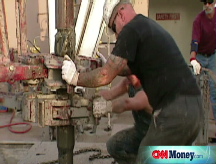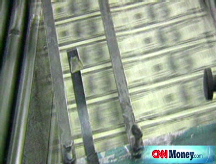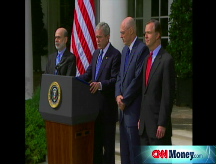Oil posts biggest-ever 1-day gain
Futures finish up $16.37 - after being up more than $25 to $130 - on the bailout plan, the falling dollar and the expiration of the October contract.

NEW YORK (CNNMoney.com) -- Oil prices posted the biggest one-day dollar gain ever Monday as the dollar was punished by the government's $700 billion Wall Street bailout plan and big investors scrambled to fill obligations as the October contract expired.
The October contract surged in afternoon trading, reaching as high as $130.00 - a more than $25 gain. But it dropped back down to settle at $120.92 a barrel, up $16.37 from Friday's close.
The gain eclipsed the $10.75 spike in oil on June 6.
The rally reached a fevered pitch as the session neared its close, partly due to the fact that Monday was the last day of trading in the October oil futures contract, which typically results in volatile trading.
"A lot of the bullish factors that had been in this market that had been ignored are now coming home to roost," said Peter Beutel, oil analyst at Cameron Hanover.
As of Tuesday, the front-month contract will be November, which settled up $6.62 to $109.37.
Late-session spike: Oil prices had been rallying throughout the day, but the late-day spike was due to investors covering their short positions as the October contract expired, according to Ray Carbone, a broker and trader at Paramount Options.
Short sellers bet the price of crude will fall, which helped send oil from nearly $120 a barrel late last month to near $90 at its lowest point. Short sellers borrow crude at one price and then have to pay it back, at what they hope will be a lower price.
When the contract expired Monday, all those short sellers were forced to buy the October contract to pay back their debt, which sent the price of oil soaring.
Carbone seemed to think that it was one company that was responsible for most of the late-day surge.
"This is probably a position that could not be moved due to last week's turmoil. So it happened on the last day of trading for October," said Carbone.
The surge in prices prompted one analyst to focus on how much of the market trades oil for investment purposes.
"It goes to show that we need to have our arms around the speculation," said Beutel. The investors who pushed up the price of oil Monday were the same "people who pushed us from $79 to over $147."
"It is all big investors," added Beutel. "When stocks, dollar go under pressure, they jump into oil and they don't care who it hurts."
Indeed, the role of intuitional investors and the issue of speculation in the oil market prompted a flurry of Congressional investigations when crude prices surged earlier this year.
The Commodity Futures Trading Commission, the government agency that oversees the oil market, issued a statement late Monday saying it is "closely monitoring" the sudden jump in oil prices.
"We are working closely with NYMEX compliance staff to ensure that no one is taking advantage of the current stresses facing our financial marketplace for their own manipulative gain," said CFTC Acting Chairman Walter Lukken in the statement.
As part of its investigation, the CFTC can compel testimony, under oath, and the production of information concerning the crude oil markets, including recent crude oil trading.
In addition, a handful of supply disruptions supported the oil market's late-afternoon rally. Refinery capacity in the Gulf Coast was still limited post- Hurricane Ike, violence in oil-rich Nigeria, and chatter of Saudi Arabia trimming production added fire to the rally, according to Andrew Lebow, a broker at MF Global.
As the price of oil is whipsawed by demand worries, Wall Street's flailing crisis, investors are having a hard time grasping oil's next move. "Traders are trying to catch knives people are throwing from the top of buildings," said Lebow.
Fed bailout: On Saturday, President Bush asked Congress for the permission to spend as much as $700 billion to purchase bad mortgage assets from already struggling financial institutions in an effort to shore up further losses as the credit crisis works its way through Wall Street.
The details of the government's attempt to prop up the financial sector were still being negotiated, but the plan aims to stem any further losses on Wall Street and resume a flow of credit that has become frozen.
"The biggest news is that people are looking at the $700 billion plan as supportive of demand, supportive of the economy," said Beutel. "Everything we are looking at right now says demand has a chance to come back if the economy starts to strengthen."
Oil prices had been trending lower on worries that demand was faltering but those concerns seem to be abating, according to one analyst.
"The fear has waned as far as the demand destruction" in the wake of the bailout news, said Neal Dingmann, senior energy analyst at Dahlman Rose. "The bailout has really stabilized this market."
The government plan "has put in some support levels in there," at least temporarily, said Dingmann. If the economy has a chance to recover, then the oil market hopes demand for energy would recover as well.
Weaker dollar: The Fed bailout "comes at a cost, the weaker dollar," said Phil Flynn, senior market analyst at Alaron Trading. Investors "will look to other currencies to park their money until this entire situation is defined."
The money that the government was planning on spending as part of the proposal "is very debasing to the value of the currency," said James Cordier, portfolio manager of OptionSellers.com.
Crude oil prices were rising as the value of the dollar fell, according to both Flynn and Cordier. Crude oil is traded in U.S. currency around the globe, so as the dollar weakens, oil becomes more expensive in dollar terms.
The plan "sounds very inflationary at first blush," said Cordier, and "it will be detrimental to the dollar while people sift through the intricacies of the bailout."
However, while the surge of liquidity would devalue the dollar in the short-term, if the money for the bailout were "approved and spent, then we think the dollar would firm up," said Cordier, as the bailout money helped restore confidence to the U.S. economy.
Demand: As the nation's economy softened and demand for energy fell off, oil prices have retreated from a record high of $147.27 a barrel, set on July 11. Oil prices have tended to decrease on signs of continued weakness for the economy and rally on signs of economic recovery.
The promise of increased liquidity in the nation's economy was supporting oil prices. "When the market was concerned that the economy was going to collapse, if nobody is lending anybody any money and there is no credit, there is not going to be a lot of energy demand," explained Flynn.
While the promise of the Fed's lifeline to the financial sector may prop up oil prices in the short term, Flynn and Cordier said oil prices were on a downward trend in the longer term.
"We have seen that these high prices are unsustainable," said Flynn. "People are going to be a lot more judicious with their energy use."
Analysts said the bailout plan provided much-needed confidence at a critical moment, preventing crude oil prices from sliding even further. However, "this knee-jerk reaction in commodities due to the U.S. dollar is short termed," said Cordier.
"Demand for energy in the U.S. continues to be weak; globally, demand is weak, too," said Cordier.
Wild week, big moves: As Wall Street was heaved around last week in a series of unprecedented shifts, so were oil prices. After Lehman Brothers (LEH, Fortune 500) announced bankruptcy, Merrill Lynch (MER, Fortune 500) agreed to be purchased by Bank of America (BAC, Fortune 500) and American International Group (AIG, Fortune 500) was resuscitated by a $85 billion loan from the government, oil prices decreased by more than $10.
However, by Friday, oil prices gained back all of those losses and then some on speculation that the government's proposed bailout plan for Wall Street would support the economy and bring demand for energy back to healthy levels.
On Sunday, federal regulators changed the status of Goldman Sachs (GS, Fortune 500) and Morgan Stanley (MS, Fortune 500) to bank holding companies, a move that opens the banks up to greater involvement in retail banking and more funding from the Federal Reserve. The re-classification also means the investment firms will be under the Federal Reserve's supervision.
Hurricanes: The Gulf Coast was still working to get back to full operation after hurricanes Gustav and Ike slammed the production and refinery-rich region.
According to the most recent situation report from the Department of Energy, 89.2% of production in the region remained shut in and 75.4% of natural gas production was still shuttered. With 9 refineries in Texas still shut down, nearly 2.3 million barrels per day less oil have been processed in the region, according to the DOE.
As of Friday, personnel were still evacuated from 225 of 717 - or 31.4 % - of manned production platforms, according to a report from the Minerals Management Service.
With additional reporting by Steve Hargreaves, CNNMoney.com staff writer. ![]()







